PAGE 43a – NOVEMBER 2005

You may have noticed that we usually feature layouts that cluster around
a theme — e.g., Switchbacks, Layouts in Containers, or Pizza Layouts.
Here’s a “Variety Pak” of layouts that don’t fit into a single theme
but have aroused our interest and may provide inspiration to you.
ONE GOOD LAYOUT DESERVES ANOTHER
 Given the challenge of building a narrow-gauge layout in a space the size of two sheets of letter paper, Andrew Knights, from the Wealdon Railway Group in England, devised this clever OO9 (HOn30) industrial switching line. He offset the two sheets (each of which measures 8-1/4×11-3/4in—A4 sized) to get a longer “main line,” and he arranged the lower (left hand) section as an Inglenook switching puzzle. As there’s no runaround track, a second locomotive will be needed to operate this line and switch cars into the two facing sidings on the right-hand section. Note, however, that if those two sidings are treated solely as switching leads (head shunts), only one switch engine is required! Photos below show Andrew’s little layout in operation. (Photos by Terry Allen.)
Given the challenge of building a narrow-gauge layout in a space the size of two sheets of letter paper, Andrew Knights, from the Wealdon Railway Group in England, devised this clever OO9 (HOn30) industrial switching line. He offset the two sheets (each of which measures 8-1/4×11-3/4in—A4 sized) to get a longer “main line,” and he arranged the lower (left hand) section as an Inglenook switching puzzle. As there’s no runaround track, a second locomotive will be needed to operate this line and switch cars into the two facing sidings on the right-hand section. Note, however, that if those two sidings are treated solely as switching leads (head shunts), only one switch engine is required! Photos below show Andrew’s little layout in operation. (Photos by Terry Allen.)
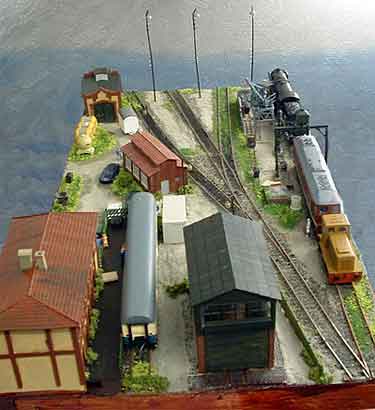
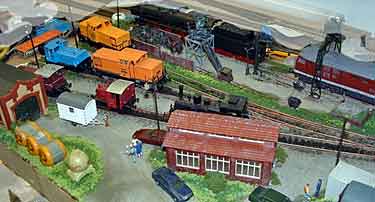
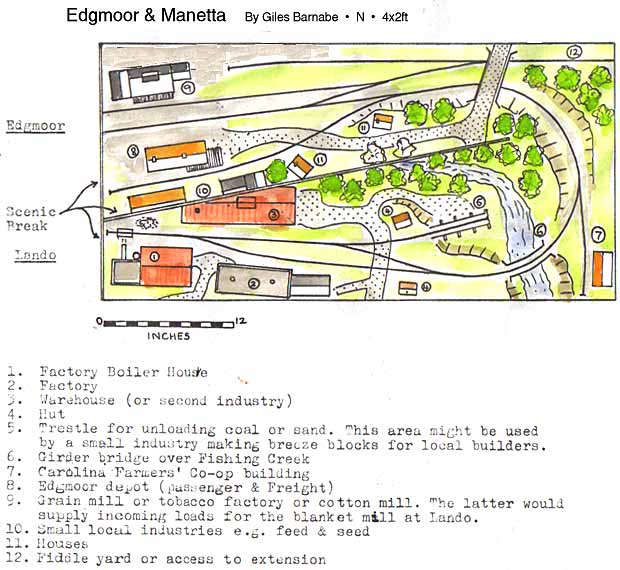
“The other track on the upper level is a tipping dock where wagon-loads of spoil are taken and dropped into trucks for disposal by road. To gain enough height to span a road vehicle I there will have to be a rising trestle leading to the tipple. Finished products — bags of cement — come out of the works and are taken down the hill to the headshunt (tail track) in front of the mine, from where they are pushed to the transfer platform for loading onto standard gauge wagons, or else go to the low-level yard track for loading onto road transport. The small stub track near the trans-shipment line will be useful to park the odd wagon being unloaded, while access is needed to the longer yard track. ”
PICTURES FROM AN EXHIBITION (OR TWO)
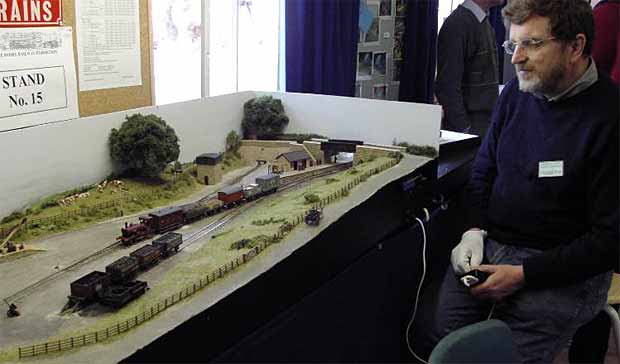
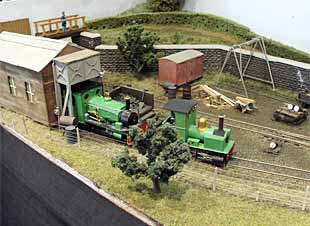
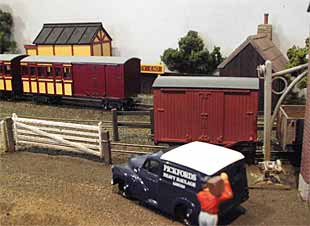
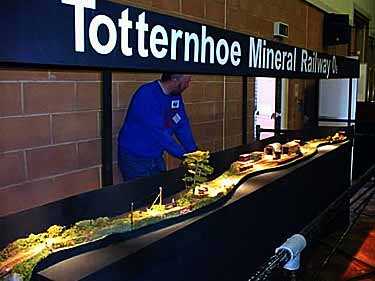 An unusual but striking approach to presenting a model layout is illustrated at left by Totternhoe Mineral Railway, built by Eamon Seddon, who now lives in Tasmania, Australia. The scale is O9/On15 (7mm to the foot on 9mm gauge). The layout is presented in a “limbo set” — a completely dark, almost invisible background. When coupled with carefully controlled lighting, the effect is to make the layout glow, much as diamonds do when displayed on black velvet. David Bromage photographed the layout at the 2005 Sydney Exhibition.
An unusual but striking approach to presenting a model layout is illustrated at left by Totternhoe Mineral Railway, built by Eamon Seddon, who now lives in Tasmania, Australia. The scale is O9/On15 (7mm to the foot on 9mm gauge). The layout is presented in a “limbo set” — a completely dark, almost invisible background. When coupled with carefully controlled lighting, the effect is to make the layout glow, much as diamonds do when displayed on black velvet. David Bromage photographed the layout at the 2005 Sydney Exhibition.A BRANCH LINE IN PATAGONIA

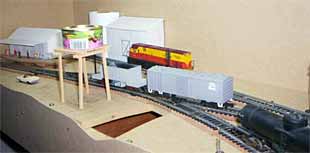
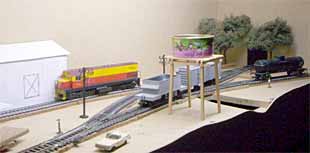
AND NOW, AS A SPECIAL BONUS…

Autumn is the season when modelers begin showing in public the exhibition layouts they’ve been constructing all year — it’s Challenge Time! This year in particular, there were two British challenges that occurred on back-to-back weekends in late October — the “cubical” challenge at ExpoNG in Swanley, Kent; and the “narrow gauge competition” at the Chelmsford (Essex) MRC show. Here are the winners. We will be showing other fascinating layouts from those contests in later issues.
At ExpoNG …
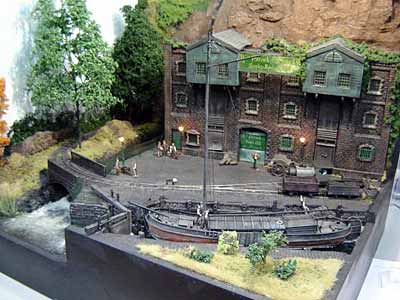 Loxley Barton Falls won the “cubic” challenge at Swanley — the layout was to be built in a cube 50cm on a side (excluding electrics and lighting). Loxley was, believe it or not, the first layout that Simon Cox had ever built! Although the photo doesn’t capture the high waterfall behind the building, it shows very well the level of detail and craftsmanship involved. Though the railway has very limited operational possibilities, it does run! For more info, see Simon’s website.
Loxley Barton Falls won the “cubic” challenge at Swanley — the layout was to be built in a cube 50cm on a side (excluding electrics and lighting). Loxley was, believe it or not, the first layout that Simon Cox had ever built! Although the photo doesn’t capture the high waterfall behind the building, it shows very well the level of detail and craftsmanship involved. Though the railway has very limited operational possibilities, it does run! For more info, see Simon’s website.
(Photo by Michael Campbell)
At Chelmsford …
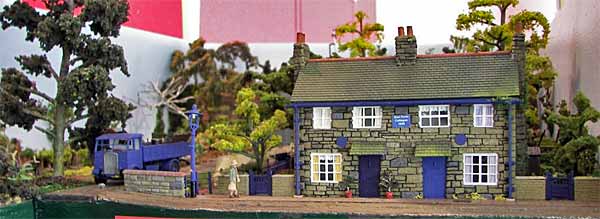
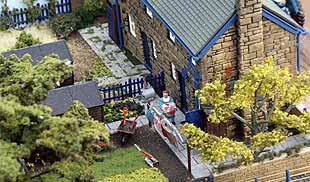
Newton Halt was the winner in the Narrow Gauge Competition at the Chelmsford Model Railway Exhibition. The rules called for a 30x20in operating narrow-gauge layout. The winner was built by Andrew McMahon and Sheila Perry. The OO9/HOn30 model is set sometime Between the Wars where the Great Western Railway crosses the Castleby Light Railway. The CLR provides a platform for passengers to and from the GWR trains. Newton Station proper (imaginary) is about 100 yards straight back, behind the GWR overbridge.
Operation, though limited, is enhanced by the use of cassettes behind the scenes to introduce a variety of stock onto the layout (photo at lower right). Andy candidly comments, “Even the best laid plans go wrong and the distance between the point blades on the LH point and the front edge of the baseboard only allowed one tank loco and one wagon to shunt into the siding. However, instead of this reducing the fun of operating, in fact it made the working of the layout more interesting.” For additional information and photos, see Andy and Sheila’s website. (Photos by Andrew McMahon)
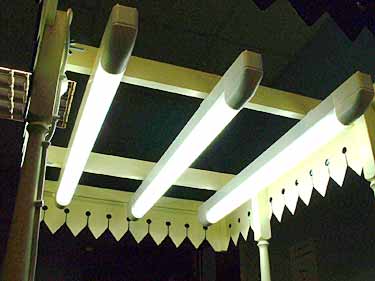
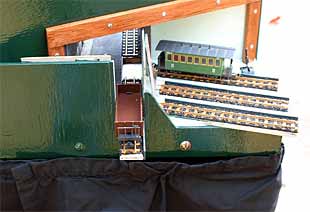
Leave a Reply